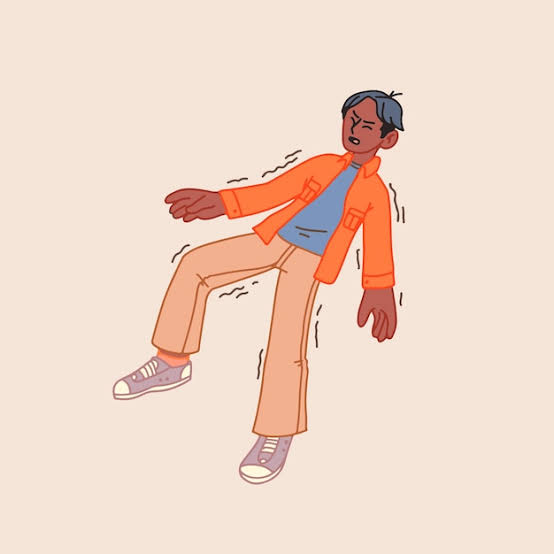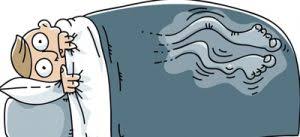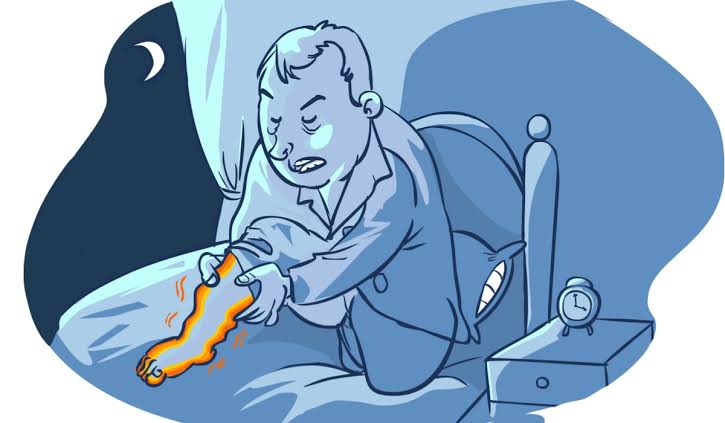The neurological condition known as restless leg syndrome (RLS), often called Willis-Ekbom illness, is characterised by an overwhelming need to move the legs and is sometimes accompanied by painful sensations. This ailment can interfere with one’s ability to unwind or sleep and usually manifests itself during periods of idleness or rest.

Pathology of Restless Leg Syndrome
Although the precise origin of RLS is unknown, a mix of environmental and genetic factors are thought to be involved. The development of RLS is significantly influenced by changes in iron metabolism and dopamine levels in the brain. These elements may result in aberrant brain-to-leg transmission, which would then cause the condition’s hallmark symptoms.
Exploring the Causes of Restless Leg Syndrome
1. Genetic Predisposition: RLS tends to occur in families, which suggests a genetic component, according to research. Your chance of having RLS is increased if you have a close family member who has the illness.
2. Dopamine Imbalance: As previously indicated, RLS symptoms may be brought on by abnormalities in the brain chemical dopamine. Leg pain might result from any disturbance in the dopaminergic regulation of muscle movements.
3. Iron Deficiency: RLS may also be influenced by low iron levels in the brain. Dopamine synthesis depends on iron, and iron deficiency might make symptoms worse.
4. Other Medical Conditions: RLS is linked to a number of illnesses, including diabetes, peripheral neuropathy, and renal failure. In certain cases, RLS symptoms might be reduced by treating these underlying causes.
Risk Factors of Restless Leg Syndrome
Although anyone can have RLS, there are a number of risk factors that raise the possibility of getting the illness:
1. Age: Although it can happen at any age, RLS is more common in middle-aged and older persons.
2. Gender: RLS is more common in women than in men.
3. Pregnancy: Although RLS symptoms may get worse during pregnancy, they frequently get better after giving birth.
4. Chronic Illnesses: People who suffer from long-term conditions such as diabetes, kidney failure, or Parkinson’s disease are more susceptible to RLS.
5. Specific Drugs: Certain drugs, such as antipsychotics and anti nausea medications, might make RLS symptoms worse.
Signs and Symptoms of Restless Leg Syndrome
The uncomfortable feeling in the legs, which is frequently described as tingling, crawling, or itching, is the distinguishing feature of RLS. The impulse to move the legs becomes overwhelming as a result of these sensations, offering momentary comfort. Although each person’s symptoms may vary in intensity, common indications and symptoms include:
1. Distasteful feelings in the legs, which occasionally spread to the arms or other body parts.
2. The impulse to extend one’s legs, which is frequently coupled with restlessness.
3. Indications that get worse when you sit or lie down, for example.
4. At least momentary relief from leg movement.
5. Nighttime or evening symptoms that are more intense and make it hard to get to sleep and stay asleep.
Managing Restless Leg Syndrome
without Medication
Although managing RLS can be difficult, there are a number of lifestyle modifications and self-help techniques that can be helpful. While some people seek therapy through conventional means, others would rather investigate complementary therapies such as homeopathy. The following are a few general management techniques:
1. Lifestyle Modifications:
– Frequent exercise helps reduce the symptoms of RLS; however, avoid doing strenuous exercise right before bed.
– Create a calming nighttime routine to assist in addressing sleep disruptions.
– Steer clear of tobacco, alcohol, and caffeine as they might make RLS symptoms worse.
2. Dietary Modifications:
– Keep a well-balanced diet high in iron, folate, and magnesium.
– If your doctor determines that you are iron deficient, you may need to take iron supplements.
3. Warm Baths and Massages:
RLS symptoms can be relieved by taking a warm bath and getting light leg massages.
4. Compression Garments:
Putting on compression stockings can help reduce symptoms and enhance blood flow in the legs.
5. Stress Reduction:
Reducing stress might exacerbate RLS. Relaxation techniques like yoga and meditation can help.
The Role of Homeopathy in Treating Restless Leg Syndrome
A holistic medical approach called homeopathy has grown in acceptance as a substitute treatment for a variety of illnesses, including RLS. It is predicated on the idea of “like cures like,” in which the body’s innate healing process is triggered by very diluted chemicals that cause symptoms comparable to the illness.
1. Individualized Treatment: Homeopathic medicine places a strong emphasis on treating each patient according to their particular symptoms and constitution. When it comes to RLS, this individualised approach can be very helpful because individual symptoms might differ greatly.
2. No Known Adverse Effects: The preparation of homeopathic remedies involves a series of dilutions and shaking, or succussion. Because of their extreme diluting power, the resulting medicines are typically regarded as safe and side effect-free.
3. Holistic Approach: Homeopathy considers the patient’s emotional and mental health in addition to their physical symptoms. This all-encompassing method can deal with RLS’s underlying causes.
4. Progressive and Gentle Healing: Homeopathy frequently offers long-lasting, progressive relief from persistent illnesses like RLS. It functions by promoting the body’s natural healing processes.
Differential Diagnosis of Restless Leg Syndrome
It is important to realise that RLS can present alongside symptoms of other illnesses. To properly diagnose RLS and rule out other possible causes, a comprehensive evaluation by a medical specialist is necessary. The following conditions could be mistaken for RLS:
1. Peripheral Neuropathy: This disorder affects the nerves in the limbs, sometimes resulting in pain, tingling, and numbness. Though the sensations in the legs may resemble RLS, it usually does not have the intense want to move that RLS does.
2. Leg Cramps: Leg cramps can result in abrupt, excruciating contractions of the leg muscles. Even though these cramps can be terrible, they are not the same as the impulse to move and the creeping, crawling feelings that RLS patients experience.
3. Venous Insufficiency: This ailment causes symptoms including edema, weight gain, and discomfort as the veins in the legs struggle to return blood to the heart. Although the underlying reasons and experiences of these symptoms differ from those of RLS, they can occasionally be confused for it.
4. Akathisia: Akathisia is a movement disease that resembles RLS in that it is characterised by a restless urge to move. It may be an adverse reaction to specific drugs, mental health issues, or neurological diseases.
5. Muscle Problems: Myositis and myopathy are two examples of muscle problems that can occasionally cause pain or discomfort in the legs. Muscle weakness is always present in these circumstances, although it is not a main characteristic of RLS.
Homeopathic Remedies for Restless Leg Syndrome
Homeopathy has become well-known in the field of alternative medicine for its ability to treat a number of medical conditions, including restless leg syndrome (RLS). The preparation of homeopathic remedies involves a special procedure called serial dilution and succussion, which is meant to encourage the body’s inherent healing ability.
Numerous homeopathic treatments for RLS have been proposed; each has unique properties and indications. Let us examine the intricacies of four popular homeopathic treatments and how they might be used to treat RLS.
Zincum Metallicum
Indications: Zincum Metallicum is frequently advised for RLS sufferers who have a persistent urge to move their feet. They may feel driven to fidget or tap their toes because they find it difficult to keep their feet still. This restlessness is especially noticeable from 5 to 7 o’clock in the evening.
Triggers: Restlessness can be aggravated by touch, which increases the demand for constant leg movement.
Potency: Zincum metallicum is usually available in potencies between 2C and 6C for homeopathic use.
Dosage: Three pills three times a day is the usual dosage recommendation for zinc metallicum. The precise dosage should be decided by a licensed homeopathic practitioner and may vary depending on the state of the patient.
Tarentula Hispanica
Indications: People with RLS who have weakness in their legs and in their choreic motions may benefit from taking tarentula hispanica. They are always itching to move their legs, and when they are uncomfortable, they frequently yawn.
Triggers: Motion, loud noises, and even contact with afflicted areas can cause restlessness. The symptoms can be made worse by touching the afflicted legs, being outside, being among bright colours, and listening to music.
Dosage: As with other homeopathic treatments, tarentula hispanica is usually advised to be taken three times a day in tablet form. A trained homeopathic practitioner should ascertain the precise dosage, considering the unique state of each patient.
Rhus Toxicodendron
Indications: People with RLS who feel comfort in continuous leg motion may benefit from rhus toxicodendron. They find it difficult to remain motionless, therefore they frequently stretch their legs to get some relaxation.
Triggers: Symptoms worsen at night, particularly on chilly, damp, rainy evenings or following a downpour. Usually, restless episodes happen at night, while you are sleeping, or when you are lying on your back or right side. Active mobility, such as walking or changing postures, along with warm, dry weather helps ease their discomfort.
Potency: Ranges from 6 to 30C.
Dosage: Three pills three times a day is the usual dosage recommendation for rhus toxicodendron. As always, a trained homeopathic practitioner should ascertain the precise dosage based on the particular condition of each individual.
Causticum
Indications: Causticum is a homeopathic treatment recommended for RLS patients who are primarily restless at night. Clear, fine weather, cold air, and dry, cold breezes all seem to exacerbate their symptoms.
Triggers: Humid, rainy conditions and exposure to heat might intensify restlessness. Additionally, the bed’s heat may exacerbate their problems.
Potency: Causticum formulations are available in 6C to 30C potencies.
Dosage: Three pills three times a day is the usual dosage for causticum. It is important to stress, nonetheless, that a trained homeopathic practitioner should ascertain the precise dosage depending on the individual’s unique situation.
It is important to use caution and professional assistance from a skilled homeopathic practitioner while incorporating homeopathic treatments for RLS. It is critical to realise that homeopathy relies on the customised treatment philosophy, which considers each patient’s distinct symptoms and constitution.
Even though these treatments might help some people, it is important to think of them as a component of a full treatment plan that also might involve lifestyle changes and, in certain situations, traditional medical interventions.
In the end, managing RLS is a complex process, and people who are exhibiting these symptoms should speak with a medical professional or a homeopathic practitioner to figure out the best course of action for their individual requirements.

In Conclusion
The challenging condition known as restless leg syndrome can have a significant negative impact on a person’s quality of life, particularly when it comes to sleep. While conventional medical treatments are accessible, homeopathy might offer a more comprehensive choice for individuals in search of recovery. Homeopathic remedies that are tailored to each patient’s particular symptoms and constitution can provide progressive and gentle recovery with a minimal risk of negative effects.
For an accurate diagnosis and individualised treatment, it is best to see a healthcare professional if you believe you may have restless legs syndrome (RLS) or if you are experiencing symptoms that might point to RLS. Never forget that, as part of a comprehensive treatment strategy for RLS, homeopathy should only be used in conjunction with lifestyle modifications and, on occasion, traditional medical therapies, even if it may be useful.
Acquiring awareness about RLS and researching various treatment alternatives empowers individuals to take control of their health and improve their overall quality of life. Consult an experienced healthcare provider about your treatment options in order to make the best judgments and determine the best course of action for managing RLS in your specific situation.
Reach out to us for a Consultation.
This blog is for information purposes. It’s crucial to note that while homeopathy is a centuries-old practice with many adherents worldwide, always consult a qualified homeopath or medical professional before initiating any treatment.
For any queries, reach out to us at contact@homeopathic.ai





